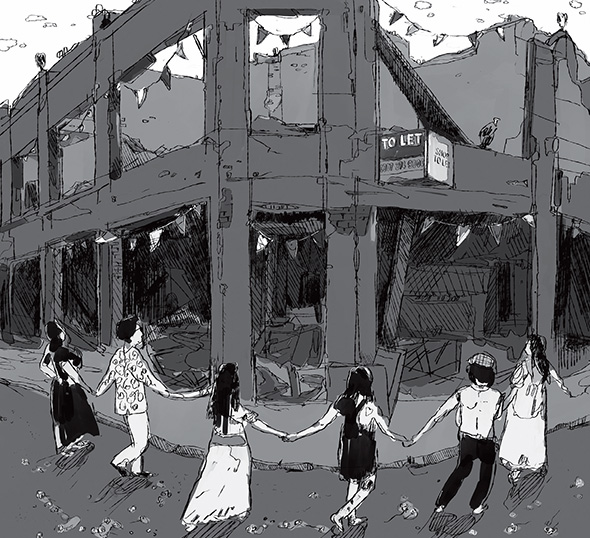The story of gentrification is familiar to us all: an area undergoes a long period of disinvestment; social housing is allowed to decay; lines of betting shops and pound stores populate the high street; public spaces fall into disrepair. The local council announces a policy of regeneration, based on a pre-prepared blueprint, and with construction firms, politicos and lawyers in tow. Some cultural icon – a theatre, an art gallery, a new “public” park – is announced to large fanfare as the centrepiece of the project. There is talk of “affordable” housing being built, an economy reborn and the return of jobs. The “vibrant” local community, referred to by pundits talking up the value of the area, is simultaneously lionised and erased.
Vanguard retail outlets begin to appear: the much-ridiculed artisan bakeries and pop-up cupcake stalls. The previous community of small traders struggle to compete. Social housing units are unceremoniously emptied; the area becomes something new, other and devoid of all the previous inhabitants who had been promised a regenerated area. To highlight one example amongst many: in Deptford, this small, once industrial patch of turf south of the river that spent decades cultivating the “Dirty” prefix to its name has been transformed in recent years. Now a new generation of inhabitants refer to desirable “warehouse aesthetics” in the area, simultaneously warning of the emergence of “yuppie culture”.
These physical signs belie the penetrating and concerted forces of gentrification at work; a dispossession mediated via multiple state institutions which shape the social and class composition of an area. In London, as in other cities around the world, the urban equivalent of a colonial force invades these new frontiers, tearing long established cultures apart whilst inhabiting their edifices, all aided by intensely racist policing and widespread cultural demonisation of migrants.
The freshly installed, quasi-communities settle around the panacea of the moment: the “creative industries”. Self-proclaimed ‘boutique’ galleries, PR start-ups and digital/new media agencies impose themselves on the ruins, their paths carved out by the restaurants and wine bars which preceded them.
A vast reserve army of ‘professional creatives’ and tech workers has emerged to service these new hubs only to find their roles being undermined by the sharing culture of the digital commons which undermines the enclosures of intellectual property. Without enclosure, culture can’t be traded as a commodity. Not only can these wares not be sold, but cultural production is becoming increasingly automated through the ever-expanding use of computer technology, swallowing up labour time.
Employees in the arts/tech/creative world (it’s getting very hard to tell them apart) are often regarded as somehow removed from the status of other workers, due to the supposed autonomy of their creative roles. This simply isn’t the case. The same exploitative practices pervade the industry: precarious employment, low levels of pay, hours and hours of unpaid overtime, a reliance on unpaid interns and, of course, an outsourcing of labour to poverty-wage sweatshops in the Global South. A classic example of this, from what many regard as a prosperous pinnacle of the arts industry, is provided by the collapse of the VFX house Rhythm & Hues, which shut its doors only weeks before winning the Academy Award for Best Visual Effects for its work on the 2013 film “Life of Pi”. Hundreds of workers found themselves uncompensated for thousands of hours of award-winning work. There is barely any collective representation of workers in these industries, although recent strikes and attempts at collective bargaining have been a welcome phenomenon amongst cinema workers across London, who have been fighting for a living wage.
The art that permeates our culture—be it through music, film, broadcasting, gaming, or the traditional settings of galleries and theaters—is largely shaped by market forces. The capitalist framework within which these art forms operate often sets boundaries on what is considered possible or profitable. Much like the mainstream entertainment industry, even the highest payout online casino operates within the parameters of what is marketable, yet it stands as a symbol of the industry’s pursuit of lucrative returns. These platforms, much like other cultural productions, can be criticized for favoring profit over innovation or critical engagement.
However, just as there are fringe movements in art that challenge conventional forms and push for a deeper examination of the structures we take for granted, there are innovations within the gaming industry that defy the norms—striving for a balance between reward and artistic experience. As these art forms chase the fragile streams of profit, creating ever more spectacular and immersive experiences, the call for new collective forms of creativity grows louder. This is a call for an alternative means of producing meaning, one that might steer us from a path seemingly headed towards cultural stagnation.
To look across London today is to observe these enterprises as an uneven development. Together they form an obstacle to progress which we can no longer fail to resist. The question “Where will we find a job?” is followed by the increasingly desperate one: “where will we live?”










